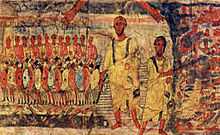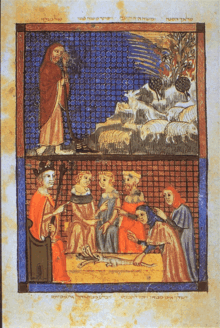Aniconism in Judaism

Aniconism in Judaism refers to the idea that Judaism forbids the creation of "graven images," commonly understood to mean the prohibition of idolatry and idol worship. While Judaism is a logocentric religion, Jews were not under a blanket ban on visual art, despite common assumptions to the contrary, and throughout Jewish history and the history of Jewish art, created architectural designs and decorations of synagogues, decorative funerary monuments, illuminated manuscripts, embroidery and other decorative or artistic religious items.[1]
In a refutation of the belief in an aniconic Judaism, and more generally in the underestimation of Jewish visual arts, modern secular historians believe that the phenomenon is a modern construction, and that "Jewish aniconism crystallized simultaneously with the construction of modern Jewish identities".[2] According to current scholarship, the notion of a total prohibition of figural representation in the Biblical and Hellenistic-Roman periods is untenable.[3][4]
Until the 20th century, Judaism was commonly believed to have been aniconic. The view was probably first challenged by David Kaufmann, who marshalled a large and comprehensive corpus of data in order to prove it untenable. He was the first to popularize the term "Jewish art" in an article published in 1878, and is regarded as the founder of the scholarly discipline of Jewish art history. His disciple Dr. Samuel Krauss wrote in 1901:
As late as ten years ago it would have been absurd to speak about a Jewish art. It is Kaufmann's own merit to have uncovered this art. Not only did he have to prove that such an art existed, he also had to prove that it could exist, as he showed that the idea that the prohibition of images would obstruct the development of such an art was mistaken, and even established it as an irrefutable fact that the art in wide areas was not prohibited insofar as no worship was associated with it.[5]

Prohibition in the Torah
[edit]A number of verses in the Torah/Tanakh refer to prohibitions against the creation of various forms of images, invariably linked directly with idolatry. The strongest source is based on what Judaism counts as the second of the Ten Commandments:
Thou shalt not make unto thee a graven image, nor any manner of likeness, of any thing that is in heaven above, or that is in the earth beneath, or that is in the water under the earth; thou shalt not bow down unto them, nor serve them; for I the LORD thy God am a jealous God, visiting the iniquity of the fathers upon the children unto the third and fourth generation of them that hate Me; and showing mercy unto the thousandth generation of them that love Me and keep My commandments.

Leviticus 26:1 reads:
Ye shall make you no idols, neither shall ye rear you up a graven image, or a pillar, neither shall ye place any figured stone in your land, to bow down unto it; for I am the LORD your God.
Similar injunctions appear in Numbers 33:52, Deuteronomy 4:16, and 27:15. In all cases, the creation of the image is associated with idolatry, and indeed, the words commonly translated as 'image' or some variant thereof (פסל pesel, שקוץ shikuts) are generally used interchangeably with words typically translated as 'idol' (e.g. אליל elil).[citation needed] (An important exception is צלם tselem, used in such verses as Genesis 1:26: "let us make man in our image", where this word for 'image' was not associated with idols.)[citation needed]

In traditional Orthodox Halakha
[edit]Despite the semantic association with idols, halakha (Jewish law) as taught by the Shulkhan Aruch (1563) interprets the verses as prohibiting the creation of certain types of graven images of people, angels, or astronomical bodies, whether or not they are actually used as idols. The Shulkhan Aruch states: "It is forbidden to make complete solid or raised images of people or angels, or any images of heavenly bodies except for purposes of study".[6][better source needed]
A breakdown can be found in the Shulkhan Aruch, section Yoreh De'ah (Kitzur Shulchan Aruch 168:1), which takes the literal meaning of פסל pesel as "graven image" (from the root פסל p-s-l, 'to engrave'.[7]) The prohibition is therefore seen as applying specifically to certain forms of sculpture and depictions of the human face.

In historical periods
[edit]Art historians believe that there was a tradition in antiquity of illuminated manuscript scrolls of books from the Tanakh among Hellenized Jews that influenced Christian works of the Late Antique and Early Medieval periods whose iconography is thought to derive from works in this tradition.[citation needed] Examples of the later works include the Joshua Roll and, more controversially, the Utrecht Psalter.

The 3rd century CE Dura-Europos synagogue in Syria has large areas of wall paintings with figures of the prophets and others, and narrative scenes. There are several representations of the Hand of God, suggesting that this motif reached Christian art from Judaism.[citation needed] A virtually unique Christian mosaic depiction of the Ark of the Covenant (806) at Germigny-des-Prés, which includes the hand, is believed also to be derived from Jewish iconography; the Ark also appears at Dura-Europos.[8] Several ancient synagogues in the land of Israel have also been excavated, revealing large floor-mosaics with figurative elements, especially animals and representations of the Zodiac.
Some of these, notably at Naaran in the West Bank, have had the living figures removed, leaving inanimate symbols such as the Temple menorah intact.[9] It has been proposed that this was done by the Jewish community in the 6th or early 7th century, as part of a controversy within Judaism over images that paralleled that within Christianity leading to the Byzantine iconoclasm, leading to a stricter attitude towards images, at least in synagogues. There is also evidence that from about 570 new synagogue mosaics were aniconic. An alternative explanation for the removals is that they were done after the Muslim conquest, and related to the decree of Caliph Yazid II in 721 (although this referred to Christian images).[10] The decoration of cave walls and sarcophagi at the Beit She'arim necropolis also uses images, some drawn from Hellenistic pagan mythology, in the 2nd to 4th centuries CE.
Some illustrations from the Middle Ages feature fantastic creatures—usually animal-headed humanoids, even when the depictions are quite clearly meant to be those of historical or mythological humans, known as zoocephalic figures.[11] A well-known example is the Birds' Head Haggadah (Germany, circa 1300). Although it is theorized that zoocephalic art is to circumvent this prohibition, the fact that some manuscripts also include human faces casts doubt on this assumption. The reasons for this illustration style are not fully understood.[12]
Illuminated manuscripts
[edit]


This section needs expansion. You can help by adding to it. (September 2024) |
A number of Jewish religious manuscripts were illustrated and include representational art, with figures such as Joel ben Simeon becoming known for their work. Archival records from medieval Iberia confirm that Jews were painters and practitioners of the fine arts.[13] A number of works survive.
- Bibles
- Haggadahs
- Barcelona Haggadah
- Golden Haggadah
- Washington Haggadah
- Sarajevo Haggadah
- Ashkenazi Haggadah
- Hispano-Moresque Haggadah
- Graziano Haggadah
- Birds' Head Haggadah
- Kaufmann Haggadah
- Sassoon Haggadah
- Sister Haggadah
- Prague Haggadah
- Rylands Haggadah
- 1739 Joseph ben David Haggadah
- Rothschild Haggadah
- Hamburg Haggadah
- Mahzorim and Siddurim
- Chronicles, Miscellany, Other Works
- Chroniques de la Bible
- North French Hebrew Miscellany
- Rothschild Miscellany
- Works of Maimonides, such as Guide to the Perplexed
- Megillat (ie, Book of Esther or scrolls of Esther)
See also
[edit]Notes
[edit]- ^ Raphael, Melissa (2016-04-05), "Judaism and Visual Art", Oxford Research Encyclopedia of Religion, doi:10.1093/acrefore/9780199340378.013.98, ISBN 978-0-19-934037-8, retrieved 2024-09-14
- ^ "(Bland 2001:8)" (PDF). Archived from the original (PDF) on 2015-05-30. Retrieved 2012-09-19.
- ^ Joseph Gutmann: "The 'Second Commandment' and the image in Judaism." In Hebrew Union College Annual 32 (1961) 161-174. [= Id.: Sacred images: Studies in Jewish art from Antiquity to the Middle Ages. [Collected studies series, CS 303]. Northampton 1989. II. 161-174].
- ^ Joseph Gutmann: "Recent literature on Jewish art: a critical appraisal." In Jewish Book Annual 25 (5728/1967-1968) 167-169. See also Gabrielle Sed-Rajna's contribution to this volume.
- ^ Dávid Kaufmann and his collections Library of the Hungarian Academy of Sciences. Original source: Dr. Samuel Krauss: David Kaufmann. Eine Biographie, p. 45. Berlin 1901 (1902). "Noch vor zehn Jahren wäre es absurd gewesen, von einer jüdischen Kunst zu sprechen. Diese Kunst entdeckt zu haben, ist Kaufmann's eigenstes Verdienst. Nicht nur mußte er beweisen, daß eine solche Kunst existire, er mußte auch beweisen, daß sie existiren könne, indem er die Meinung, als stehe das Bilderverbot der Kunstentfaltung im Judenthum im Wege, als irrig erwies, er es vielmehr als unwiderlegbare Thatsache hinstellte, daß die Kunst auf flachem Raume nie verboten war, insofern kein Götzendienst sich daran knüpfte."
- ^ "Shulchan-Aruch - Chapter 11". Torah.org. Archived from the original on 2000-04-21. Retrieved 2012-09-19.
- ^ See Exodus 34:1, 4; Deuteronomy 10:1, 3.
- ^ The only ancient Jewish image of the Ark appears to be at Dura-Europos although it also appears as the oldest Jewish bible illustrations surviving, from the 10th century (see Beckwith) Beckwith, John (1988). Early Medieval Art. Brill Archive. pp. 14–16. ISBN 90-04-08115-1.
- ^ Barber, 1018-1021
- ^ Barber, throughout.
- ^ Gertsman, Elina (2023-09-01). "'The Breath of Every Living Thing': Zoocephali and the Language of Difference on the Medieval Hebrew Page". Art History. 46 (4): 714–748. doi:10.1111/1467-8365.12742. ISSN 0141-6790.
- ^ Kogman-Appel, Katrin (2018), "Material Culture and Art", The Cambridge History of Judaism, pp. 860–881, doi:10.1017/9781139048880.032, ISBN 978-0-521-51724-9, retrieved 2024-09-16
- ^ Mann, Vivian B. (2019-12-31), "The Unknown Jewish Artists of Medieval Iberia", The Jew in Medieval Iberia, 1100-1500, Academic Studies Press, pp. 138–179, doi:10.1515/9781618110541-007, ISBN 978-1-61811-054-1, retrieved 2024-09-14

References
[edit]- Barber, Charles, The Truth in Painting: Iconoclasm and Identity in Early-Medieval Art, Speculum, Vol. 72, No. 4 (Oct., 1997), pp. 1019-1036, JSTOR
- Beckwith, Martha Warren (1994). Early Medieval Art 206 illustrations, 53 in colour Carolingian. Ottonian. Romanesque. Praeger. ISBN 978-0-500-20019-3.
- Bland, Kalman P. (2001). The Artless Jew Medieval and Modern Affirmations and Denials of the Visual (PDF). Princeton University Press. ISBN 978-0-691-08985-0. Archived from the original (PDF) on 2015-05-30. Retrieved 2006-03-16.
- Goody, Jack (1997). Representations and Contradictions Ambivalence Towards Images, Theatre, Fiction, Relics and Sexuality. Wiley-Blackwell. ISBN 978-0-631-20526-5.
